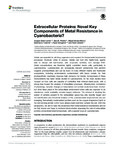Extracellular Proteins: Novel Key Components of Metal Resistance in Cyanobacteria?
| dc.contributor.author | Giner-Lamia, J | |
| dc.contributor.author | Pereira, SB | |
| dc.contributor.author | Bovea-Marco, M | |
| dc.contributor.author | Futschik, Matthias | |
| dc.contributor.author | Tamagnini, P | |
| dc.contributor.author | Oliveira, P | |
| dc.date.accessioned | 2017-02-07T20:12:11Z | |
| dc.date.available | 2017-02-07T20:12:11Z | |
| dc.date.issued | 2016-06-07 | |
| dc.identifier.issn | 1664-302X | |
| dc.identifier.issn | 1664-302X | |
| dc.identifier.other | ARTN 878 | |
| dc.identifier.uri | http://hdl.handle.net/10026.1/8422 | |
| dc.description.abstract |
Metals are essential for all living organisms and required for fundamental biochemical processes. However, when in excess, metals can turn into highly-toxic agents able to disrupt cell membranes, alter enzymatic activities, and damage DNA. Metal concentrations are therefore tightly controlled inside cells, particularly in cyanobacteria. Cyanobacteria are ecologically relevant prokaryotes that perform oxygenic photosynthesis and can be found in many different marine and freshwater ecosystems, including environments contaminated with heavy metals. As their photosynthetic machinery imposes high demands for metals, homeostasis of these micronutrients has been widely studied in cyanobacteria. So far, most studies have focused on how cells are capable of controlling their internal metal pools, with a strong bias toward the analysis of intracellular processes. Ultrastructure, modulation of physiology, dynamic changes in transcription and protein levels have been studied, but what takes place in the extracellular environment when cells are exposed to an unbalanced metal availability remains largely unknown. The interest in studying the subset of proteins present in the extracellular space has only recently begun and the identification and functional analysis of the cyanobacterial exoproteomes are just emerging. Remarkably, metal-related proteins such as the copper-chaperone CopM or the iron-binding protein FutA2 have already been identified outside the cell. With this perspective, we aim to raise the awareness that metal-resistance mechanisms are not yet fully known and hope to motivate future studies assessing the role of extracellular proteins on bacterial metal homeostasis, with a special focus on cyanobacteria. | |
| dc.format.extent | 878- | |
| dc.format.medium | Electronic-eCollection | |
| dc.language | eng | |
| dc.language.iso | en | |
| dc.publisher | Frontiers Media SA | |
| dc.subject | metal resistance | |
| dc.subject | cyanobacteria | |
| dc.subject | exoproteome | |
| dc.subject | secretion | |
| dc.subject | biotechnology | |
| dc.title | Extracellular Proteins: Novel Key Components of Metal Resistance in Cyanobacteria? | |
| dc.type | journal-article | |
| dc.type | Journal Article | |
| plymouth.author-url | https://www.webofscience.com/api/gateway?GWVersion=2&SrcApp=PARTNER_APP&SrcAuth=LinksAMR&KeyUT=WOS:000377170700001&DestLinkType=FullRecord&DestApp=ALL_WOS&UsrCustomerID=11bb513d99f797142bcfeffcc58ea008 | |
| plymouth.issue | JUN | |
| plymouth.volume | 7 | |
| plymouth.publication-status | Published | |
| plymouth.journal | Frontiers in Microbiology | |
| dc.identifier.doi | 10.3389/fmicb.2016.00878 | |
| plymouth.organisational-group | /Plymouth | |
| plymouth.organisational-group | /Plymouth/Faculty of Health | |
| plymouth.organisational-group | /Plymouth/Users by role | |
| dc.publisher.place | Switzerland | |
| dcterms.dateAccepted | 2016-05-24 | |
| dc.identifier.eissn | 1664-302X | |
| dc.rights.embargoperiod | Not known | |
| rioxxterms.versionofrecord | 10.3389/fmicb.2016.00878 | |
| rioxxterms.licenseref.uri | http://www.rioxx.net/licenses/all-rights-reserved | |
| rioxxterms.licenseref.startdate | 2016-06-07 | |
| rioxxterms.type | Journal Article/Review | |
| plymouth.oa-location | http://journal.frontiersin.org/article/10.3389/fmicb.2016.00878/full |


